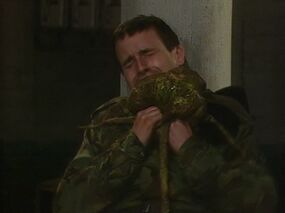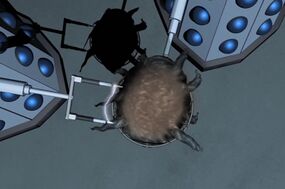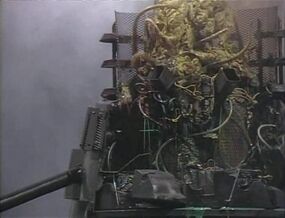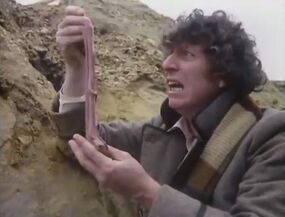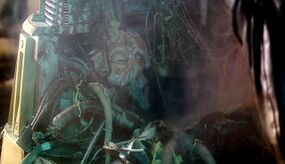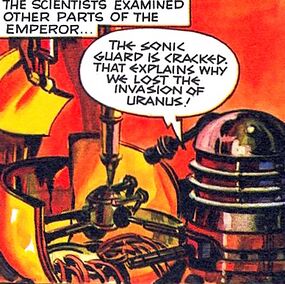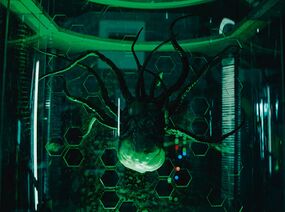Dalek mutant
Dalek mutants, (AUDIO: Order of the Daleks, The Ultimate Adventure) also called Dalek creatures (TV: Genesis of the Daleks; AUDIO: Return to Skaro) or Kaled mutants (TV: Destiny of the Daleks, AUDIO: Genetics of the Daleks, Paradox of the Daleks) were the true forms of the Daleks and the mutated descendants of a race of humanoid forebears, variously identified as the Kaleds, (TV: Genesis of the Daleks) the Dals, (TV: The Daleks) the humanoid Daleks, (COMIC: Genesis of Evil) or even humans. (PROSE: We are the Daleks!)
Being dependent on them for mobility, (COMIC: Genesis of Evil, TV: Destiny of the Daleks) or sometimes even for immediate survival, (TV: The Daleks) the organic occupants spent their whole lives enclosed in protective armour and weaponry, mounted in the upper parts of the Dalek travel machines. The Third Doctor once described the Kaled mutant to Sarah Jane Smith as "a living, bubbling lump of hate". (TV: Death to the Daleks)
In one instance, the Daleks of Skaro used the term "Dalek mutant", or Mutant Dalek, to distinguish a new race that they deemed to have deviated from "the purity of the Dalek bloodline". (AUDIO: Blood of the Daleks)
Biology[[edit] | [edit source]]
Overview[[edit] | [edit source]]
Dalek mutants had a fundamental DNA type of 467-989. (TV: Daleks in Manhattan) They were cephalopods, being large brained creatures with tentacles, though young mutants were globular, soft and shapeless with tendrils. (TV: Genesis of the Daleks) The Eleventh Doctor claimed that "there [wasn't] a bone in [a Dalek's] body", (TV: Victory of the Daleks) although one dead Dalek mutant's carcass, found by Steven Taylor on the planet Shade did contain some "bone" as well as "gristle" within the rotting "bladder" of the mutant's body. (AUDIO: Across the Darkened City) According to Bernice Summerfield, Dalek mutants were the "same species" as their Kaled ancestors. (AUDIO: The Lights of Skaro) Despite this, Dalek DNA was sufficiently different from both Kaled and Thal, that the Daleks could not operate machines coded to one of the other species. (AUDIO: Temmosus)
Daleks mutants varied in appearance as all their young mutated differently, with varying numbers of limbs and other body parts. According to one one account, this was due to all embryos mutating differently during incubation with mutants resmbling squids, spiders, and others creatures "so grotesque it seemed heresy to give them a name at all". (PROSE: Dalek)
The mutants were typically grown in an aqueous environment (TV: The Power of the Daleks) and placed into their casings once viable. (PROSE: Dalek) The incubation units were used to generate many mutants. (PROSE: Dalek Combat Training Manual) All Daleks would regularly have some of their genetic material extracted, enabling it to be used in reproduction plants to create new mutants. (AUDIO: The Mutant Phase) Extraneous body parts were hacked off from young mutants when first installed into their travel machines. The Metaltron was born with two good eyes, but only one was deemed necessary and the other was gouged out with a spike. The "surplus material" would be taken to incubation vats and used in the creation of more Dalek embryos. (PROSE: Dalek)
Although usually dependent on their travel machines for offence/defence, the bare mutant could be dangerous; even the young were quite lethal and capable of strangulation with their tentacles. They attacked the fourth and seventh incarnations of the Doctor, trying to throttle him. (TV: Genesis of the Daleks, Remembrance of the Daleks) The Fifth Doctor once said that they had a deadly sting, and during a 1984 incursion into London, one of these creatures, separated from its casing, attacked and injured a human soldier without difficulty. (TV: Resurrection of the Daleks) Constance Clarke theorised that the mutants had a venomous bite. (AUDIO: Order of the Daleks) When removed from its casing, a Dalek reconnaissance scout was capable of controlling a human's movements, and using them as a vehicle in the absence of a casing. (TV: Resolution)
The mutants did require nutrients, usually fed to them by the life support systems of their travel machines. They could feed on proteins, vegetable matter and could metabolize various forms of radiation. The Skaro city Daleks fed on fruits and vegetables which were grown using hydroponics and artificial sunlight. (TV: The Daleks AUDIO: The Lights of Skaro). Dalek embryos grown in the Incubation Level of the city were fed on a cocktail of nutrients drawn from the Lake of Mutations, controlled by environment computers. This same fluid also sustained the Dalek Supreme, extending its lifespan far beyond normal Dalek years (AUDIO: Return to Skaro).
Daleks could also feed on blood. Members of the Brotherhood of the Black Petal donated their blood to the survivors of the squad that had crashlanded on the planet Strellin, indirectly allowing them to ingest the Dream Flower extract and assert their malign influence over the brothers (AUDIO: Order of the Daleks) Protein could also be collected from their victims, and pathogens were destroyed by their casing's antibodies. (TV: Into the Dalek)
Daleks were hard-wired to keep living no matter the cost, (TV: The Witch's Familiar) and could reach very long lifespans. One Dalek remained operational for four thousand centuries. (AUDIO: The Lights of Skaro) Despite this, Dalek mutants still aged and over time the body would break down and liquefy. On Skaro in the Dalek City decaying Daleks were stored in the city's sewers. Fittingly, the Dalek word for sewer was the same as their word for graveyard. (TV: The Witch's Familiar)
When deprived of power, Dalek mutants could enter a dormancy inside their casings. They remained inert until power was restored, even after centuries of hibernation. (TV: The Power of the Daleks) Early Daleks, unable to store power, would go into "standby" mode when they were shut off. The Seventh Doctor hypothesised this was how the Daleks had survived his first encounter with them, and that one day someone would breach the city's walls and "wake them up". (AUDIO: The Lights of Skaro)
According to some accounts, the voice of a Dalek was electronic as the actual vocalisations from the mutants amounted to little more than squeaking sounds. Without the assistance of their casing, they were unable to produce speech as they did not possess tongues or vocal chords. (TV: Resurrection of the Daleks, AUDIO: Jubilee) During the Last Great Time War, however, Dalek infants could be born with vocal chords, but these were severed and replaced with "more reliable" synth replacements. (PROSE: Dalek) Other accounts differed, suggesting that Dalek mutants, even in an advanced state of decay, could "mewl" in an approximation of the usual Dalek voice. (TV: The Witch's Familiar)
Dalek mutants were quite possibly fatal to a Time Lord when eaten. (PROSE: The Scarlet Empress) However, their "Dalek juice" could be ingested by humans with no apparent ill-effect, though some people found it flavourless, or disgusting. (AUDIO: Jubilee)
Sources vary as to how long Daleks could outside their casings. According to one account, after a while their lungs would collapse, their hearts would fail, and their brains could liquefy. (AUDIO: In Remembrance)
As observed when a Dalek stationed on Arkheon was executed by two of Dalek X's Elite Guard Daleks, the Dalek mutant within was fried alive, while its casing was left blackened but otherwise intact and able to be recycled, as Dalek X ordered. (PROSE: Prisoner of the Daleks)
The mutants on occasion demonstrated an accelerated healing ability in response to localised wounds. One Dalek mutant in particular, while being tortured by Commander Farrow, began to repair its damaged body, its flesh growing over Farrow's hand and burning it. (AUDIO: Jubilee) On one occasion, the Kaled mutant of a recon scout survived the destruction of its casing and being trisected, going into hibernation with the pieces being separated across Earth for over a thousand years. After one piece was awakened via ultraviolet light, the mutant was able to use a spatial shift to pull the pieces back together and reform itself. (TV: Resolution)
Variations[[edit] | [edit source]]
Dalek mutants often varied in appearance, as the Daleks continuously altered their DNA, (TV: Victory of the Daleks) though kept the same basic structure of a relatively-octopoid species with a comparatively large brain. Because the mutants were genetically designed to "not die," as they aged they would degenerate and liquefy. (TV: The Witch's Familiar)
Davros's original mutants were yellowish-green globs with tendrils able to lash out and choke someone. (TV: Genesis of the Daleks) Thousands of years later, during the Dalek-Movellan War, the Daleks divested themselves of organic matter to better understand their robotic foes, leaving their organic forms in the Skarosian wilds, (PROSE: Dalek Combat Training Manual) where they liquified into gurgling pink blobs, that could be stretched and handled, but had no apparent tentacles, brain, or eyes. When this led to an impasse of robotic logic, (TV: Destiny of the Daleks) the Daleks returned to their organic roots. (PROSE: Dalek: The Astounding Untold History of the Greatest Enemies of the Universe, TV: Resurrection of the Daleks, etc.)
Some mutant variants included one with a clawed "hand". (TV: The Daleks) Other mutations were green blobs with tendrils that were "scooped" into their casings. (TV: The Power of the Daleks, The Evil of the Daleks)
During the Imperial-Renegade Dalek Civil War, the mutants were eyeless and green with whip-like tentacles. (TV: The Five Doctors, Resurrection of the Daleks) The Imperial Daleks commanded by Davros were surgically altered, with their appendages physically grafted into their machines, which the Renegade Daleks saw as impure. (TV: Remembrance of the Daleks)
Others, after the Last Great Time War, were pale-pink, blue-green or green-brown with one large functioning eyeball and a small vestigial socket. The remnants of a face could be seen, more clearly on some mutants than on others; as well as the functioning eye and the sealed-up eye, a nose and mouth were vaguely discernible. (TV: Dalek, The Parting of the Ways) The mutants created using human cells produced small, blue-green creatures, apparently consisting purely of a head, with two eyes and an overall clearer "face". (TV: The Parting of the Ways)
Dalek Sec had lower tentacles that were long enough to grab hold of an adult human and an unusual, trunk-like appendage that could envelop and carry a whole adult human. (TV: Daleks in Manhattan)
Mutants of the New Dalek Empire were each grown from a cell of Davros' own body. Davros described them as "new Daleks... true Daleks". (TV: The Stolen Earth)
Being grown from Davros' cells however, the DNA of the New Empire's Daleks (PROSE: Dalek: The Astounding Untold History of the Greatest Enemies of the Universe) was "unrecognisable as Dalek". Three survivors of the Empire's fall were able to perennially restore their race after an encounter with the Doctor, using a progenitor, tricked the Eleventh Doctor into helping create a New Dalek Paradigm, possessing pure DNA but still maintaining the appearance of other post-Time War mutants. (TV: Victory of the Daleks, Asylum of the Daleks, Into the Dalek, COMIC: The Only Good Dalek, GAME: City of the Daleks, The Doctor and the Dalek)
During the Last Great Time War, the mutants of the Glider Daleks resembled a limbless humanoid torso. (PROSE: Engines of War)
Display[[edit] | [edit source]]
While most Dalek mutants were hidden within their casings, certain individuals had their true form on open display. The first known Dalek to do this was the Dalek Supreme who ruled the Dalek City. (AUDIO: Return to Skaro) This practice was also employed by several Dalek Emperors. The mutant form of the Dalek Emperor in the Last Great Time War, was visible through a glass case within its immense casing, (TV: The Parting of the Ways) as was that of the Emperor who ruled the New Dalek Paradigm in an alternate timeline. (GAME: City of the Daleks)
After breaking the time-lock and retrieving Davros from the Time War at the cost of his sanity, Dalek Caan resided in the Crucible, the heart of the New Dalek Empire, in a broken casing which exposed his mutant form. (TV: The Stolen Earth/Journey's End)
The Parliament of the Daleks was led by the Prime Minister of the Daleks, who situated itself in a clear glass tube where it was protected by the rest of the Parliament who were armed and would protect him. (TV: Asylum of the Daleks)
History[[edit] | [edit source]]
For an account of the creation of the Daleks, see separate article.
According to research papers read by the Fifth Doctor on Riften 5, Dalek mutants involved in the "War of Sharpened Hearts" were all sourced from a genetic code found to have originally been from male Kaleds. Recalling this, the Seventh Doctor imagined that the DNA of all Dalek mutants came exclusively from men, believing Davros had reached a sexist conclusion that female Kaleds were of a "inferior genetic stock". (PROSE: Christmas on a Rational Planet) However, female Kaleds had actually indeed been harvested for their DNA by Davros, with the Kaleds Milal and Kelleher coming to exist during the Last Great Time War due to time distortion caused by the Dalek that held their places in the main timeline. (AUDIO: Effect and Cause) On the planet of the Neverwhen, several Daleks likewise devolved into female Kaleds by the superweapon. (AUDIO: The Neverwhen)
In the era of Dalek history where the Dalek War Machines were confined to the Dalek City, new Dalek mutants were grown in an aqueous solution drawn from the Lake of Mutations on the city's incubation level. (AUDIO: Return to Skaro)
Sometime prior to 2323, a Dalek flying saucer suffered a crash landing. Twelve surviving mutants were recovered by Earth forces and used to fuel the psychoscapes of the Dalek Dome. (COMIC: Liberation of the Daleks [+]Loading...["Liberation of the Daleks (comic story)","Liberation of the Daleks"])
During the Dalek-Movellan War, the Daleks reengineered themselves into quasi-robotic creatures to understand their foes, ejecting their organic selves into the wilds of Skaro. (PROSE: Dalek Combat Training Manual) After this led to an impasse, (TV: Destiny of the Daleks) the Daleks reintroduced organic matter into themselves. (PROSE: Dalek: The Astounding Untold History of the Greatest Enemies of the Universe)
Dalek mutants appeared different over time, and, as noted above, during the war between the Imperial and Renegade Dalek factions, the two sides had physical differences, with Davros' side now altered into true cyborgs and physically made one with their travel machines, (TV: Remembrance of the Daleks) whereas they had only used the casings as battle armour and were not actually integrated into them. (AUDIO: The Four Doctors)
Iris Wildthyme once became fatally ill after eating a live Kaled mutant. (PROSE: The Scarlet Empress)
Major Jenny Maguire of UNIT once joked that they should defrost a "squiddy thing" from the stores and release it onto the press, following the London UFO crash in 2006. (PROSE: Operation London)
During the Last Great Time War, the Daleks, fearing the telepathic power of the Sensorites, bred a hybrid mutant with Sensorite DNA, implanting it in the Interior to turn the Sensorites against all aliens. When Ian Chesterton and Susan Foreman entered the Interior, they managed to defeat the mutant, convincing the Sensorites to join the Time Lords' war effort. (AUDIO: Sphere of Influence)
Daleks, with casing variants from across their history, returned to Skaro to make it anew. The Dalek City possessed "living" sewers where the walls were made of decaying, liquefying, enraged mutants that would attack other Daleks if they could. When rejuvenated by Time Lord regeneration energy the decaying Daleks rose up and destroyed the Dalek City. (TV: The Witch's Familiar)
In the far future, Dalek mutants infested the ruined weapons factories on Villengard as the Daleks repeatedly tried and failed to kill Rusty, the "good Dalek". When the Twelfth Doctor came to Villengard to see Rusty, the mutants menaced him as well as his first incarnation, Bill Potts' glass avatar and Archibald Hamish Lethbridge-Stewart, the latter of whom mistook them for rats. However, they were soon warded off by the Doctors using the elder Doctor's sonic screwdriver. Though it took time for the younger Doctor to realise what exactly they were, he was able to partly recognise them on sight, having encountered such mutations on his first visit to Skaro. (TV: Twice Upon a Time, PROSE: Twice Upon a Time)
Individual cases[[edit] | [edit source]]
A reconnaissance scout that appeared on Earth in the 9th century, suggested by the Thirteenth Doctor to be the first out from Skaro, survived being cut into three pieces after losing its casing to a human army in the Battle of Hope Valley. Practising caution, the Three Custodians took each piece to different parts of the planet, and ensured that they were guarded by their descendants, so it would not recover. However, the third Custodian was shot by an arrow in Yorkshire, before he could complete his journey. On New Year's Day 2019, the Lost Custodian's piece of the Kaled mutant was found by archaeologists Lin and Mitch. Inadvertently revived under ultraviolet light, the piece summoned its other parts. The Dalek subsequently took control of Lin, and used her to gain intelligence, acquire transport, and retrieve its old gunstick. Using remnants of its old shell, combined with spare parts found at Dinkle's farm, Lin built this Dalek a new metal casing. Letting Lin go, the Dalek went on a rampage before it was stopped by the Doctor and Team TARDIS using a microwave oven which melted its new casing. Though the mutant latched onto Aaron Sinclair, it was finally thwarted when the Doctor jettisoned it from their TARDIS into a supernova. The Dalek attempted to take Aaron with it, but Ryan managed to reach his father who fought off the Dalek's control while his son pulled him to safety. (TV: Resolution)
Intercepting a Dalek traitor, the Daleks forced open its casing before exterminating the mutant within, leaving a vacant casing which was used to contain the Doctor. (TV: The Power of the Doctor)
In the Warrior's universe, a pair of Dalek mutants operated within a single Dalek casing, becoming known as the Twin Dalek. (AUDIO: Aftershocks)
Behind the scenes[[edit] | [edit source]]
- In the first TV appearance of the Daleks in The Daleks a single clawed hand of the mutant (a reptilian-like hand with three golden nails in the remake film Dr. Who and the Daleks) was revealed. The comic The Daleks and other media revealed many "facts" about the Daleks which did not appear on television. Nevertheless, the full appearance of the inner creatures remained undisclosed until The Daleks' Master Plan on television, as the mutants writhe in agony due to the effects of the Time Destructor. In this serial, they appeared as fleshy, almost-spider like creatures. They appeared again in The Power of the Daleks in the form of newly created creatures. They appeared in their adult form in The Evil of the Daleks. The mutants appeared as eyeless shapeless creatures with tendrils in both of these instances.
- They first appeared in colour in Genesis of the Daleks (as young) and as adults in Destiny of the Daleks. In the latter story, the Fourth Doctor makes statements which imply that the Daleks have now abandoned any organic component and have turned themselves into robots. Future stories did not explain or elaborate and returned to the previous concept of the Daleks as ultimately organic. The Five Doctors showed much of the adult Kaled mutant for the first time.
- From Series 1 onward, the Kaled mutants went through a major re-design. They now had a single functional eye, more defined bodies and 11 ropy tentacles, though the mutant seen in City of the Daleks had 12 tentacles instead of the usual 11.
- James Johnson's "headcanon"[1] for his Time War-era Dalek models, which were featured on the cover of Gallifrey: War Room 1: Allegiance, established that the Dalek Commanders were specifically bred mutants whilst Reconnaissance Daleks were battle proven mutants that had survived previous campaigns and were programmed in the art of guerilla warfare, espionage and reconnaissance.[2][3]
